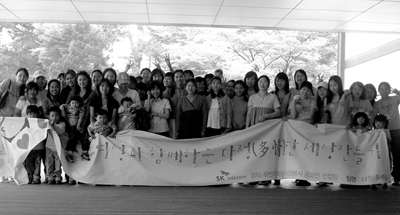
According to statistics released by the Ministry of Justice, the number of international marriage has increased 70 times in the past 15 years, from 500 in 1991 to 35,000 in 2005. Currently, the number of foreign female immigrants is expected to be more than 60,000. While most people presume that such marriages happen only in the countryside where there is shortage of brides as well as labor, it has become more common to see the same thing happening in city neighborhoods as well.
To deal with this influx, several government policies have been established. In 2005, the government permitted tax breaks for families that include a foreign female and granted permanent residence to foreign spouses who have lived in
However, many foreign women who have married into Korean families still complain of hardships. Helping to ease the burden of these women, volunteer groups organized by university students, including one at Ewha called Dajung. who strive to satisfy the remaining difficulties.
Dajung, which stands for warm-heartedness in Chinese, is a volunteer group formed to help foreign women married to Korean men in
These members mostly assist women from
When the members visit their students once a week, they often help translate stacks of documents like medical prescriptions that have been put aside to wait for them. Since most of these foreign immigrant women become pregnant as soon as they get married, most students also have experienced working as a nanny. Park Bo-ram (Statistics, 3), the current President of Dajung says, “My Russian student has two children and since they are young we each hold one child while we study.” Some of Dajung members actually teach their students’ children too.
Since students’ learning abilities and environments vary, each student is taught in a different way. For instance, Park’s student was already able to speak Korean when she first met her, thus she focuses more on actual practice. “We call 114 and ask for the number of a Chinese restaurant, call Pizza Hut and order a pizza or go out to the street and practice locating a certain place. Even when she knows the way, I tell her to ask people passing by.”
Therefore, each class becomes an unforgettable event or an episode to the teachers. Kim Hee-jun (Political Science and Diplomacy, 3), who volunteers as a Korean teacher at a center for foreign women, said that she had to adapt to a gradually decreasing number of students in her beginners’ class. “Students stop coming to class after two or three months because they get pregnant. At the end, there weren’t any students left to teach,” said Kim.
Nowadays, Dajung members have their own teaching styles based on their experiences, but it wasn’t as easy as it is now in the beginning. “I attended my first class assuming that they would speak English, just a little. However, I remember having struggled the first day explaining fundamental concepts such as sit down, raise your hand, open the book, and so on,” says Kim.
However, the Dajung members’ sweat turns into tears when they see their students actually improving and adjusting to their new life, most of all, when they present their teachers with Christmas cards written in broken Korean.
Other than teaching Korean, Dajung members also hold events to let students experience Korean culture. This semester, students are planning to visit
Kim justifies her efforts with an analogy: “Why do we help people with handicaps? Just like people with disabilities, foreign women desperately need our help as well. Besides, they are our family; they are married to Korean men and raise children who will be living as a Koreans. There is even a program called PEACE Buddy that lets foreign exchange students be supported by a Korean friend. These women also need a companion to talk to.” University students are in a position where they can understand and share these women’s hardships most effectively, since they are about the same age, says Kim. Indeed, most of the foreign immigrant women are in their early 20s and the eldest student is in her mid 30s.
However, Dajung members believe that the key to making a better living environment for these women is for people to change their perspectives first. “It is important for officials to constantly draw up plans that support foreign female immigrants married to Koreans, but people’s viewpoints should change the most. People often take a jaundiced view of foreign immigrant women, surmising that they get married and come to

